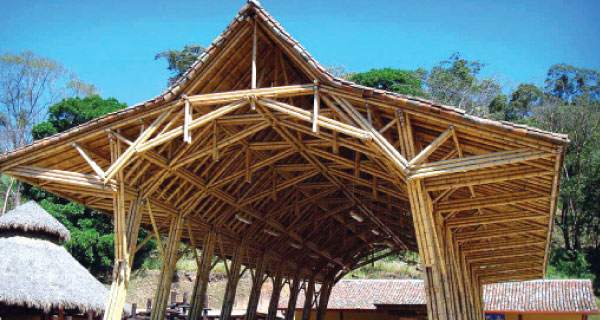 |
|
A building constructed using bamboo |
By LYDIA LIMBE
We rarely think about it as a building material for houses. We may have heard that it can build an excellent house, but for some reason, we shy away from it. It is bamboo.
“Many people think that bamboo is weak because it is hollow. Plus, the ones who have tried to use it, have used bamboo without being treated, therefore it does not last more than four years,” says Samuel Jakinda, the proprietor of Kwethumbe Tented Lodge in Gwasi. He is in the process of building the lodge using bamboo poles as support structure for the tented lodge.
Prof Jacob Kibwage of South Eastern University has sensitised people in different regions of the country on the different uses and advantages of growing bamboo, to the extent of building demonstration houses.
Even though these houses are supposed to send the message to the public that it can be done, many are still skeptical about it, a notion that Sylvia Essendi says is due to lack of sensitisation on bamboo uses.
Floor to roof
“You can build a house with bamboo from the floor to the roof, and it is a house as strong as any other, and with the comfort of today’s civilisation state,” says Essendi, an architect whose university major is in bamboo.
What does one need to know while building a house with bamboo? “For starters, you have to inform your architect that you would like to use bamboo as a building material, so that the design and strength is catered for by the architect, structural and mechanical engineer,” says Essendi.
One stem of bamboo grows between four to 12 metres tall and can be up to 15 metres wide. The lowest part of the bamboo stem is the widest, while the upper part is the thinnest. The whole bamboo stem is used in building the house.
“The wide parts of the bamboo are used for the beams and columns as per the structural drawings or requirements. The thin parts of bamboo are woven together to make the background for the floor finishing or roof finishing,” Essendi points out.
One thing you have to consider when using bamboo as the main building material is that it does not get into contact with water. Water makes bamboo rot, the floor has to be raised and the roofing done such that it protrudes a good distance from the wall. This is to protect the bamboo wall from the rain.
The stems of the bamboo are riveted together to the desired thickness, depending on the load the column and beams will carry.
“There are different species of bamboo, and once you have determined which one you will use, the strength is determined. Be sure to properly treat the bamboo so that it does not to get infected by insects,” she adds.
Before selecting bamboo to treat, ensure it is old enough — about four years since it was planted. The reason is that a three to five-year-old bamboo culm has sufficiently hardened (lignified), maximising the physical properties of the bamboo. These mature poles also shrink and crack less when dry and have a lower starch and sugar content that decreases the attractiveness for insects and fungi.
The thin bamboo tops not suitable for structural use are immediately processed into flattened bamboo matts for cladded formwork and bamboo shingle roofs.
Stay informed. Subscribe to our newsletter
If bamboo needs to be protected from water, how would you handle the wet areas? “For my resort, the bathroom, toilet and kitchen are made of stabilised blocks,” says Essendi.
A composite building is what you will end up with. Essendi adds that you need to consider the weather of the area you are building on; this will determine how the bamboo is used.
“If building for a cold area, you will need to have some insulation to keep away the cold. This means you have to place Styrofoam in between bamboo panels, or use rammed earth to fill in between the panels,” she adds.
The roofing and walling bamboo can be split into half and riveted together, or used while whole. For the roof, before placing the roofing panels, a polythene paper has to be laid on to keep the water out.
The alignment of the roof is a steep A-shape to ensure no water collects at the bottom of the panelling. Bamboo, just like wood, is available in engineered boards imported majorly from China.
Is there any bamboo available locally?
“There are lots of lands under bamboo. In fact, we have bamboo forests with over-matured stems waiting to be harvested. You only need to get a licence to harvest bamboo from Kenya Forest Research Institute to get started,” says Prof Kibwage of South Eastern University College.
Locally available
“I was interested in using bamboo as part of the tented lodge building material from environmental conservation efforts I was engaged in. I knew there were some growing within close proximity of the designated lodge, but did not know how to identify which one was best. Prof Kibwage then introduced me to several farmer groups that could supply me with the ideal size,” says Jakinda.
Is bamboo safe from fire? “As a stop-gap measure for fire, you can spray the bamboo with fire-proof vanish. This will reduce the speed with which fire consumes your house. However, this does not mean you throw caution to the wind. You still have to put in necessary fire response measures in the event the unfortunate happens,” Essendi cautions. Other than vanishing for fireproofing, bamboo can be vanished in the colour that suits the homeowner’s taste. While fitting the electrical lines, the hollow part of the bamboo can be used as duct pipes.
How does bamboo compare to other conventional materials on the overall costs of building? “For my tented lodge, the most commonly used tent support is the electricity or telephone line poles. Having opted for bamboo, in my calculation, I estimated that it would cost me more than 50 per cent less,” Jakinda says.
“The overall cost highly depends on the location of the construction site, which determines the cost of transporting the bamboo from the harvesting point,” concludes Essendi.
 The Standard Group Plc is a
multi-media organization with investments in media platforms spanning newspaper
print operations, television, radio broadcasting, digital and online services. The
Standard Group is recognized as a leading multi-media house in Kenya with a key
influence in matters of national and international interest.
The Standard Group Plc is a
multi-media organization with investments in media platforms spanning newspaper
print operations, television, radio broadcasting, digital and online services. The
Standard Group is recognized as a leading multi-media house in Kenya with a key
influence in matters of national and international interest.
 The Standard Group Plc is a
multi-media organization with investments in media platforms spanning newspaper
print operations, television, radio broadcasting, digital and online services. The
Standard Group is recognized as a leading multi-media house in Kenya with a key
influence in matters of national and international interest.
The Standard Group Plc is a
multi-media organization with investments in media platforms spanning newspaper
print operations, television, radio broadcasting, digital and online services. The
Standard Group is recognized as a leading multi-media house in Kenya with a key
influence in matters of national and international interest.







